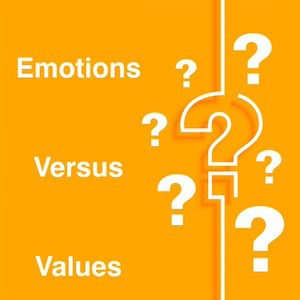Some people muddle together values and emotions when they discuss motivation. These are two very different (though causally related) phenomena. Some people get confused about the roles of thought and action in forming values and triggering emotions. I thought I’d sort these issues out in one place.
The terms
A value (in the psychological sense) is an object in memory, one that corresponds to a real or imagined existent that one has acted purposefully to gain, keep, or create.
So, my husband, my business, my integrity, and the Yankees are all values of mine. You have thousands of values, which exist in a value hierarchy. Your value hierarchy is fairly stable, but it does change gradually over time as you change your priorities, discover new values, and pursue your goals.
An emotion is a combination of an image, affect, and sometimes impulses; it is an introspective experience, which can be observed directly, not something stored in memory that needs to be inferred. I think of an emotion as an alert to a value at stake.
The cause of emotions (which we infer) is the expectation of a benefit or harm. How do we form such an expectation? Based on past experiences stored in memory in relation to our values, and on present awareness of our values and the present situation.
The role of thought and action in forming values
Action is the primary programmer of values. You are not born with values. (You have only a few built-in needs and a built-in pleasure-pain mechanism.) It is not enough to associate something with pleasure. What turns it into a value structure is your taking action to get that thing, and then experiencing the pleasure. The combination of self-generated action and pleasure is critical.
It is only if something is stored as a value that it then has the capability of causing emotions.
But having said this, it’s important to add that thinking is a self-generated action! Thinking can create a value where there was no value before. That’s what happens when you go through a logical process and come up with a goal to set that will help you gain some other value. This new goal is immediately stored as a value, and typically this value produces at least a little desire to gain and keep it. But sustained action takes a strong value that causes a strong desire. A value is strengthened the most by action to gain and/or keep it in the world. It is weakened by failing to take such action.
I’ve written extensively on the topic of values and how they are changed. The #1 resource is my blog post on How Values Form, which is part of a series on The Concept of ‘Value.’ There’s a lot on this topic in the series on happiness, too.
The role of thought and action in triggering emotions
Emotions are created on the fly by the affective system in response to the awareness of values at stake in the moment.
A value is at stake when your own action will affect whether you gain, keep, harm, or lose the value. That awareness is absolutely, inextricably interrelated with your thinking or non-thinking at the moment (and your perception) and the context that is activated (which consists of connections that were caused by your past thinking).
So ideas are the efficient cause of emotions.
But emotions are ephemeral. They come. They go. When the situation or the object of thought changes, you get a new emotion. Emotions can change in a split second when you get new information or a change in perspective.
(If you find that an emotion is continuous, you are likely continuing to think about the same issue. For example, if you’re in a funk, you’re probably thinking about all of the bad aspects of your present situation.)
In contrast, physical actions affect emotions indirectly. When you move, the perceptual context changes, and therefore emotions must change. This is inevitable.
Hence, I recommend physical action in a couple of important tactics for breaking out of an emotional loop. For example, I recommend taking a physical pause to help you reset the context. I recently wrote about the benefit of a 3-minute walk devoted to activating a different context.
The bottom line:
Values are stored objects in your memory; they are relatively stable and change slowly over time. You cannot observe your values directly; you infer them from your emotional reactions. It takes concerted effort to change your stored values.
Emotions are an introspectable experience. They flit and change with every change of attention. You can learn to manage your emotions by learning how to control your attention through thought and action, by developing self-understanding of your own values, and by changing your values.








I don’t understand why ” You cannot observe your values directly; you infer them from your emotional reactions.” Are you suggesting we can only observe our emotional reactions? Husband and Yankees are surely observable. What I am not able to grasp is why the distinction of observation and inference is important.
Hi, Harry,
Thanks for the question!
You can see your spouse and the Yankees, of course. But you can’t “see” the fact that they are values to you. I mean this in the psychological sense–that these objects are stored in your memory banks as important and good for you. But if they are so stored, you will feel certain kinds of feelings about them.
It is not uncommon to realize you don’t value something that you thought you “should” value or “did” value. For example, college students may take action to learn a subject, because they were told they should, but realize afterwards that they don’t care about it at all. It’s not a value to them.
I hope this is helpful.
Yours,
Jean M.